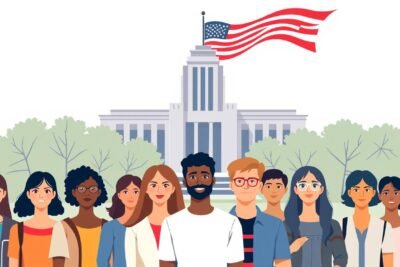
Income Driven Repayment Federal Loans USA: Eligibility and Application

Quick story: You call your friend Mia after a confusing servicer email. She spent an hour on studentaid.gov and found a plan that cut her monthly bill and kept her account in good standing. That calm feeling is what we want for you.
This guide gives a plain-English roadmap to the income driven repayment federal loans USA topic and shows how a plan can lower what you pay over time.
You’ll learn who qualifies, how monthly amounts are set, and when balances can be forgiven. We’ll cover recent court moves that paused the SAVE option and what that means now.
Expect clear steps to check options using the Department of Education’s Loan Simulator, tips to protect your credit, and practical next steps so you can act with current information.
- Your present-day guide to income-driven repayment in the United States
- How income-driven repayment plans work
- Eligibility and loan types: who qualifies and when consolidation helps
- Comparing IDR plans available now
- Income driven repayment federal loans USA: choosing the right plan for your situation
- Applying successfully: your step-by-step path
- Recertification, errors, and staying on track
- Benefits, trade-offs, and the policy horizon
- Your next steps to secure an affordable monthly payment
Your present-day guide to income-driven repayment in the United States
Before choosing a plan, get a quick update on how recent legal and policy moves change options.
Why IDR exists: An income-driven repayment plan sets your monthly payments as a share of discretionary income and factors in your family size. This helps you keep current when earnings drop. The idea is simple: lower payments when you need it so you avoid delinquency and protect credit.
What’s changed lately: The landscape is unsettled. Court orders have blocked the SAVE plan and paused cancellations under PAYE and ICR. Right now, IBR remains the only option still providing IDR cancellation for some borrowers.
Congress has proposed replacing current options with a Repayment Assistance Plan (RAP) that would add a $10 minimum payment and extend forgiveness to 30 years. That bill is not law yet.
These shifts may affect how your payments count toward forgiveness. Check messages from your servicer and the department education site before you change plans.

How income-driven repayment plans work
Start by learning what counts as discretionary income and why that number shapes your monthly payment.
Discretionary income explained
Your monthly payment is set from discretionary income, which compares your income and family size to the federal poverty line.
Under IBR and PAYE that metric is earnings above 150% of the guideline. ICR uses income above 100% (or a 12-year alternative).
Payment caps and timelines
Plans cap your payment at roughly 10%, 15%, or 20% of discretionary income to keep the amount affordable.
Terms extend to about 20 or 25 years. That gives lower monthly payments now, but it can stretch how long you carry interest.
Forgiveness and tax notes
If a balance remains after the set years, the remainder may be eligible for forgiveness. Starting in 2026, forgiven amounts may be taxable under current law.
"Plan ahead for both short-term relief and long-term costs annual recertification keeps the payment aligned with your situation."

| Plan feature | Typical cap | Typical term (years) |
|---|---|---|
| IBR / PAYE | 10%–15% | 20 |
| ICR | 20% | 25 |
| Common benefit | Payment caps | Forgiveness after term |
Eligibility and loan types: who qualifies and when consolidation helps
Start by checking which of your balances count eligibility hinges on loan type and history.
Federal student aid only: Direct, FFEL, and Parent PLUS realities
Only government-held student aid qualifies for these plans. Private education debt won't apply.
Direct loans are broadly eligible. Many FFEL borrowers can use IBR, but other plans may need consolidation first.
Parent PLUS borrowers can access IDR only through ICR and only after a Direct Consolidation Loan is created.

When you may need a Direct Consolidation Loan
Consolidation can unlock plan access and help if you target PSLF or broader options. But consolidating can change eligibility for PAYE.
Check whether consolidation repaid a Parent PLUS; that step can block PAYE for those funds.
Married borrowers, filing status, and servicer checks
Your loan servicer will use your reported income and family size to set a monthly payment.
Filing jointly usually means both incomes count. Filing separately often limits consideration to your wages.
"Document your household and loan types before you apply — it speeds review and reduces surprises."
- Confirm which account types you hold.
- Consider consolidation only when it helps access a better plan or PSLF credit.
- Have tax and household information ready for your servicer.
| Situation | Likely outcome | Next step |
|---|---|---|
| Direct loans | Wide plan access | Apply or recertify with servicer |
| FFEL loans | IBR often available; other plans limited | Consider Direct Consolidation Loan |
| Parent PLUS | ICR only after consolidation | Create a Direct Consolidation Loan |
For more guidance on eligibility and consolidating to access specific plans, see our partner guide at student aid consolidation help.
Comparing IDR plans available now
If you want to lower monthly costs, compare how each plan caps payment and counts years toward forgiveness.
Income-Based Repayment (IBR)
What it does: Caps your payment at 10%–15% of discretionary income and runs about 20–25 years. It works for most Direct and many FFEL accounts and is eligible for PSLF. As of spring 2025, IBR is the only plan still offering IDR cancellation for some borrowers.
Pay As You Earn (PAYE)
What it does: Caps payments at 10% with a 20-year forgiveness timeline. PAYE’s cancellation is currently paused due to pending litigation tied to SAVE.
Income-Contingent Repayment (ICR)
What it does: Sets payment at 20% of discretionary income or uses a 12-year alternative formula and cancels after 25 years. It’s the route for parent plus loans after you create a Direct Consolidation Loan.
Saving on a Valuable Education (SAVE)
Current status: SAVE is blocked. New enrollments are not allowed and many who were on SAVE were placed into forbearance that does not count toward PSLF or IDR cancellation. When active, SAVE would have waived unpaid interest above your required payment.
Quick tips: Consider years to forgiveness, payment caps, and legal status before switching. If you have parent plus loans, weigh ICR via consolidation against other strategies to protect your progress.
| Plan | Typical cap | Years to forgiveness | Notes |
|---|---|---|---|
| IBR | 10%–15% | 20–25 | PSLF-eligible; only plan currently offering IDR cancellation |
| PAYE | 10% | 20 | Cancellation paused pending SAVE litigation |
| ICR | 20% or 12-year formula | 25 | Required for parent plus loans after consolidation |
| SAVE | Varies (would limit unpaid interest) | Would match other IDR terms | Blocked now; many enrollees in non-crediting forbearance |
Income driven repayment federal loans USA: choosing the right plan for your situation
Run a side‑by‑side check before you change plans.
Start by signing in to the Department of Education’s Loan Simulator to get an estimated monthly payment based on your income family and family size. The tool shows outcomes for every eligible plan and gives a quick monthly payment based comparison across scenarios.
FFEL and Parent PLUS paths
If you hold FFEL balances, test whether a Direct Consolidation Loan opens better plan choices or PSLF credit. Parent PLUS borrowers must consolidate first to try ICR.
Balance short‑term savings and long‑term cost
A lower monthly payment can ease your budget now but raise total interest and extend years in repayment. If you work in public service, check how each plan affects PSLF credit before you switch.
- Model married filing jointly vs. separately when relevant.
- Include likely changes in family size or income over the next few years.
- Consider small extra payments to cut interest while keeping required payments low.
- Factor past forbearance or deferment into your timeline for forgiveness and credit.
| Decision | What to test | Quick guidance |
|---|---|---|
| Keep current plan | Current payments vs. projected cost | Good if you’re close to PSLF or forgiveness years |
| Consolidate FFEL | Access to more plans and PSLF | Use simulator to compare payoff timeline |
| Parent PLUS path | ICR after consolidation | Compare payments and years to forgiveness before committing |
| Switch when rules change | Rerun simulator if SAVE reopens or RAP passes | Keep notes of assumptions to speed future reviews |
Tip: Save your simulator results and assumptions so you can rerun scenarios during annual recertification or after life changes.
Applying successfully: your step-by-step path
Follow this simple checklist to turn paperwork into an approved plan and lower your monthly payment.
Prepare documents first. Gather your latest tax return or IRS transcript, recent pay stubs if your earnings changed, and a clear count of household members. Add marital status and contact details so your application processes faster.
Where to apply. Go to studentaid.gov to start the application, or request a paper form from your loan servicer if you prefer. You can also contact your loan servicer to submit required information.
Choose a plan or ask for the lowest payment
You may select a specific plan, or ask the Department of Education to place you in the option that gives the lowest monthly payment. If you expect Public Service Loan Forgiveness, confirm the plan is PSLF-qualifying before switching.
Keep making payments until confirmed
Continue to make on-time payments under your current terms until your servicer confirms the change. If you have multiple servicers, submit applications to each so all accounts transition.
- Submit accurate contact information so the servicer can request missing documents.
- Save confirmations, upload receipts, and note submission dates for future recertification.
- If your tax data changed, include a recent pay stub or alternative documentation to speed review.
Tip: Monitor your account messages and email after submission so you can resolve requests quickly and avoid gaps in coverage.
Recertification, errors, and staying on track
A short annual check-in can protect your progress toward forgiveness and your credit score. Plan ahead so recertification does not become a scramble.
Annual recertification using IRS data and why opting in matters
Opt in under the FUTURE Act to let the IRS share tax data. That choice reduces paperwork and helps your servicer set the right payment for the year.
Mark your calendar 30–60 days before your recertification date and gather updated pay stubs or tax records.
What to do if your payment seems too high
If a calculation looks wrong, contact your loan servicer right away and ask for a review with supporting documentation.
If the servicer does not fix the issue, file a complaint with the Federal Student Aid Ombudsman and include your application and any replies.
Income changes mid-year: documenting drops to adjust monthly payments
If your income falls mid-year, submit proof pay stubs, termination letters, or benefit notices to request an immediate recalculation.
Stay current: keep making payments until a change is confirmed to protect credit and preserve your repayment timeline.
"Automate corrected payments and keep dated records of each recertification to avoid surprises later."
Benefits, trade-offs, and the policy horizon
Balancing short‑term relief with long‑term costs is the core trade‑off every borrower must weigh today.
- Relief and protection: Lower monthly payments can stop delinquency and protect your credit right away. A $0 or reduced payment gives breathing room when money is tight.
- Trade‑offs: Stretching payments over more years raises total interest and can lengthen your time in repayment. That difference matters if you plan to aim for forgiveness or want to minimize overall cost.
- Legal landscape: Court actions have blocked SAVE and paused cancellations under PAYE and ICR. IBR still counts toward IDR cancellation for many borrowers. Watch updates from the Department of Education so you can react fast.
- RAP proposal: The House bill would add a $10 minimum payment and extend forgiveness to 30 years. That may keep more people engaged, but small mandatory payments can still lead to missed payments and collections for some households.
"Choose a plan that keeps payments manageable today while preserving credit and crediting years toward your goal."
| Feature | Near‑term effect | Long‑term effect |
|---|---|---|
| Lower payments | Reduce delinquency risk | Higher interest over time |
| IBR (current) | Counts toward cancellation | May extend years in plan |
| RAP (proposed) | $10 minimum boosts engagement | Forgiveness at 30 years; possible higher total cost |
Your next steps to secure an affordable monthly payment
Take these practical steps now to lock in a lower monthly payment and protect your credit.
Start by logging in to the Department of Education’s Loan Simulator and compare plans using your income, family, and size details. Gather tax records and submit your application at studentaid.gov or through your servicer.
Keep making payments on your student loan until the servicer confirms the new payment. Turn on auto-debit and opt into IRS data sharing so your amount updates each year with fewer forms.
Check your account monthly to confirm payments apply correctly. If something looks off, contact your servicer with documentation and escalate to the FSA Ombudsman if needed.
Revisit your choice when your work, family, or income changes so the plan stays affordable and your credit remains protected.
If you want to know other articles similar to Income Driven Repayment Federal Loans USA: Eligibility and Application you can visit the category Federal.




Leave a Reply